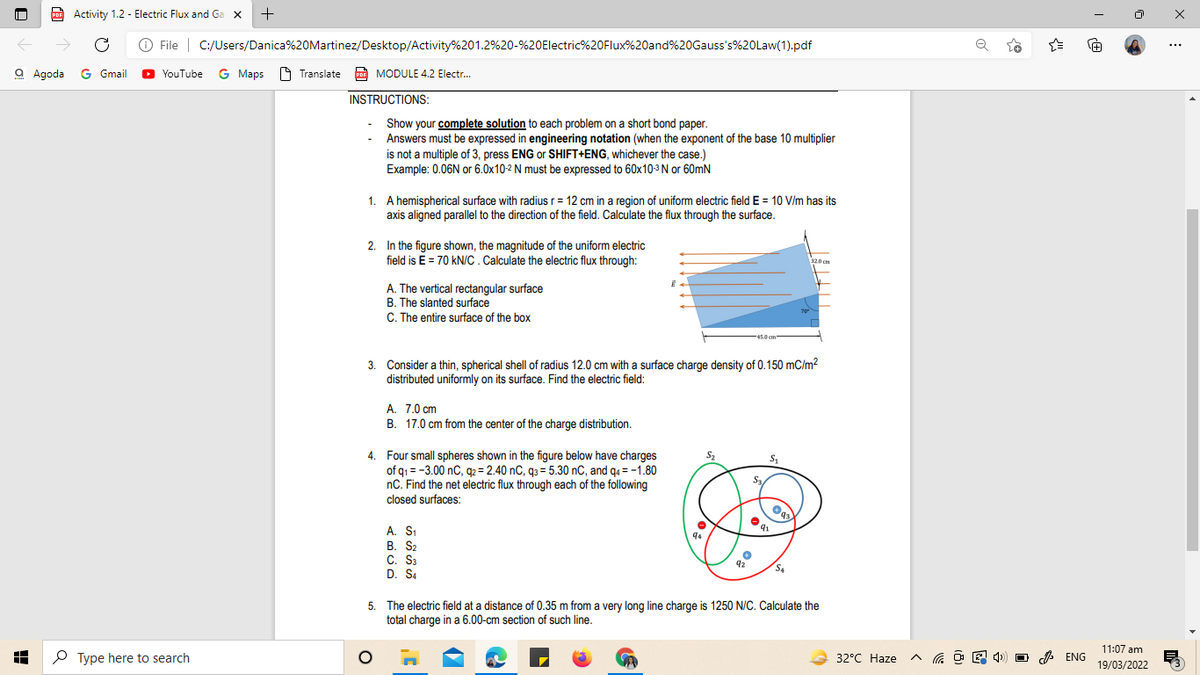A. The vertical rectangular surface B. The slanted surface C. The entire surface of the box 3. Consider a thin, spherical shell of radius 12.0 cm with a surface charge density of 0.150 mC/m² distributed uniformly on its surface. Find the electric field: A. 7.0 cm B. 17.0 cm from the center of the charge distribution. 4. Four small spheres shown in the figure below have charges
A. The vertical rectangular surface B. The slanted surface C. The entire surface of the box 3. Consider a thin, spherical shell of radius 12.0 cm with a surface charge density of 0.150 mC/m² distributed uniformly on its surface. Find the electric field: A. 7.0 cm B. 17.0 cm from the center of the charge distribution. 4. Four small spheres shown in the figure below have charges
Principles of Physics: A Calculus-Based Text
5th Edition
ISBN:9781133104261
Author:Raymond A. Serway, John W. Jewett
Publisher:Raymond A. Serway, John W. Jewett
Chapter19: Electric Forces And Electric Fields
Section: Chapter Questions
Problem 12OQ: In which of the following contexts can Gausss law not be readily applied to find the electric field?...
Related questions
Question
M1.2
-answer number 3 only
-complete solution

Transcribed Image Text:PDF Activity 1.2 - Electric Flux and Ga x
+
O File | C:/Users/Danica%20Martinez/Desktop/Activity%201.2%20-%20Electric%20Flux%20and%20Gauss's%20Law(1).pdf
+1
...
a Agoda G Gmail
YouTube G Maps O Translate E MODULE 4.2 Electr.
INSTRUCTIONS:
Show your complete solution to each problem on a short bond paper.
Answers must be expressed in engineering notation (when the exponent of the base 10 multiplier
is not a multiple of 3, press ENG or SHIFT+ENG, whichever the case.)
Example: 0.06N or 6.0x10-2 N must be expressed to 60x10-3 N or 60mN
1. A hemispherical surface with radiusr = 12 cm in a region of uniform electric field E = 10 V/m has its
axis aligned parallel to the direction of the field. Calculate the flux through the surface.
2. In the figure shown, the magnitude of the uniform electric
field is E = 70 kN/C. Calculate the electric flux through:
320 cm
A. The vertical rectangular surface
B. The slanted surface
C. The entire surface of the box
45.0 cm
3. Consider a thin, spherical shell of radius 12.0 cm with a surface charge density of 0.150 mC/m2
distributed uniformly on its surface. Find the electric field:
A. 7.0 cm
B. 17.0 cm from the center of the charge distribution.
4. Four small spheres shown in the figure below have charges
of g1 = -3.00 nC, q2 = 2.40 nC, g3 = 5.30 nC, and g4 = -1.80
nC. Find the net electric flux through each of the following
closed surfaces:
S2
S,
A. S,
B. S2
C. Sa
D. S4
92
S4
5. The electric field at a distance of 0.35 m from a very long line charge is 1250 N/C. Calculate the
total charge in a 6.00-cm section of such line.
11:07 am
P Type here to search
32°C Haze
A ENG
19/03/2022
Expert Solution
This question has been solved!
Explore an expertly crafted, step-by-step solution for a thorough understanding of key concepts.
This is a popular solution!
Trending now
This is a popular solution!
Step by step
Solved in 2 steps with 2 images

Knowledge Booster
Learn more about
Need a deep-dive on the concept behind this application? Look no further. Learn more about this topic, physics and related others by exploring similar questions and additional content below.Recommended textbooks for you

Principles of Physics: A Calculus-Based Text
Physics
ISBN:
9781133104261
Author:
Raymond A. Serway, John W. Jewett
Publisher:
Cengage Learning

Principles of Physics: A Calculus-Based Text
Physics
ISBN:
9781133104261
Author:
Raymond A. Serway, John W. Jewett
Publisher:
Cengage Learning